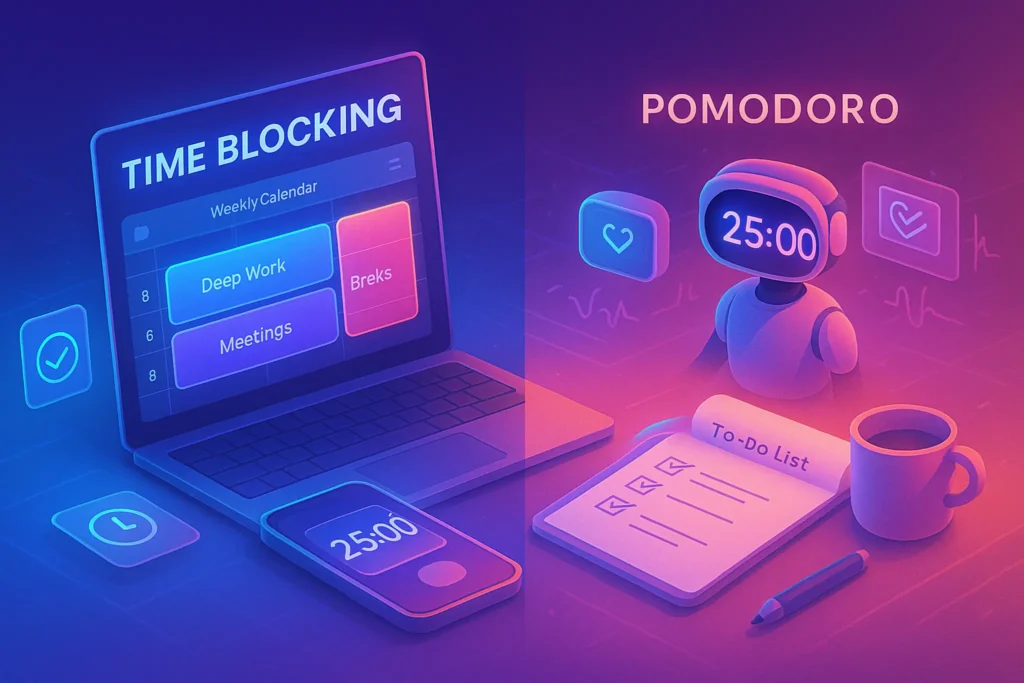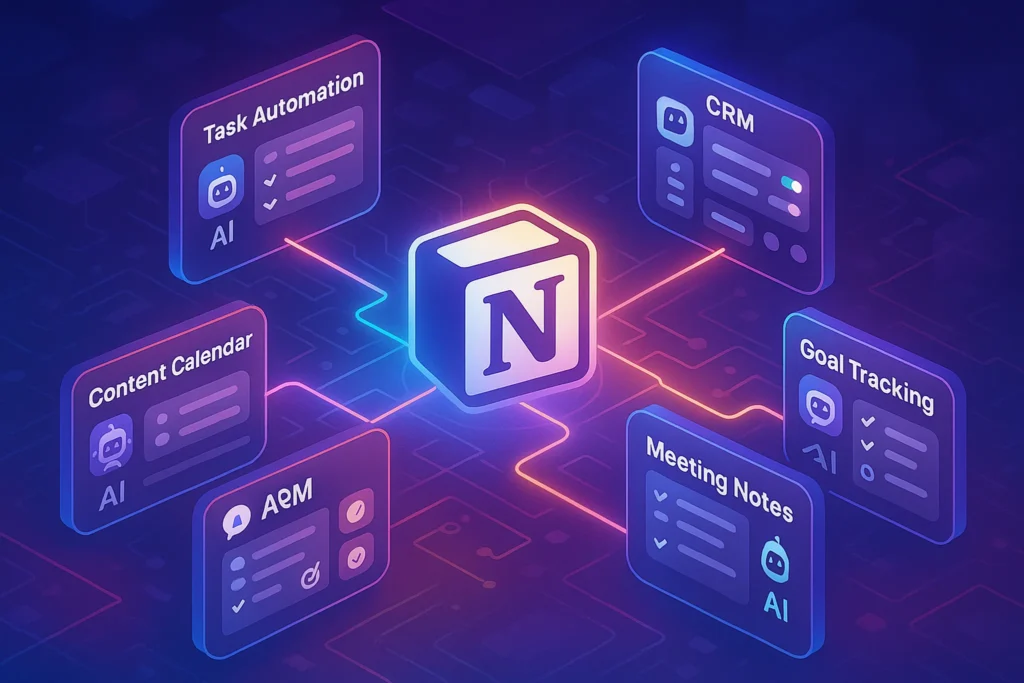-This post may contain affiliate links. If you click on one and make a purchase, I may earn a small commission at no extra cost to you.-
🧭 Introduction: Two Paths to Productive Focus
Every day you sit down to work, you face the same question: “Where should I start?” Two of the most popular productivity methods—Time Blocking and Pomodoro—promise discipline and clarity, but they operate very differently. Time Blocking partitions your calendar into distinct work segments, while Pomodoro breaks time into focused sprints. This article unpacks both methods, highlights their strengths and weaknesses, explains when to choose each, and shows how to combine them into a customized, powerful workflow. By the end, you’ll know exactly what suits your brain and schedule best.
🗺️ Method 1: Time Blocking — Sculpting Your Day
Time Blocking transforms a fragmented workday into a guided experience. Rather than drifting from task to task on impulse, you pre-assign your work hours into focused segments for different priorities. When you do this in the morning—or better yet, the night before—you eliminate decision fatigue and gain intentionality. Over time, your brain learns: 9–11 AM equals deep writing, 2–3 PM means admin, and 4–5 PM is reserved for learning.
This clearly defined structure helps you avoid the cumulative loss of productivity that comes from constant context-switching. You begin to see your days not as chaotic to-do lists, but as meaningful chapters, each with its own objective. Whether you’re drafting a report or studying, these intentional blocks build a flow state you didn’t think possible in the messy day-to-day.
If you’re new to this system, our Beginner’s Guide to Time Blocking offers templates and real-world examples to get started. Just a few days of blocking can make you feel like you’re finally steering your day, rather than reacting to it.
🔍 Focus Sculpted in Advance
Time Blocking is about designing your day in advance by assigning specific blocks to different types of tasks—deep work, routine admin, meetings, breaks, reflection, and even buffer time. Instead of reacting to your inbox, you’re deciding what to focus on and when.
In your calendar, you might assign 8–10 AM to writing, 10–11 AM to email triage, 11:30–1 PM to creative collaboration, and 2–4 PM to project work. This visual structure eliminates decision fatigue and creates an intentional flow.
🧠 The Science Supporting It
Studies in cognitive psychology show that switching between tasks robs you of at least 15–20 minutes per switch, eroding efficiency. By entrusting your focus to a scheduled block, you reduce that friction entirely. You also create a mental “start signal” for tasks—your brain understands what you’re about to do simply by seeing the block.
✅ Who It Works Best For
Time Blocking works best for people with medium-to-long tasks and creative workflows—writers, analysts, strategists—where the thinking benefit increases with longer, uninterrupted stretches. It also helps professionals with recurring daily demands—writers needing uninterrupted mornings, managers needing buffer times before meetings, or parents balancing work and child care.
🏁 Method 2: Pomodoro Technique — Sprint and Reset
The Pomodoro Technique is simplicity itself—but deceptively powerful. By working for exactly 25 minutes and breaking for five, you’re asking your brain only to stay present for a short sprint. No pressure to maintain stamina, no fear of burnout. After four sprints, a longer break refreshes your mind and resets your motivation.
What makes Pomodoro effective is its rhythm. Every ‘tomato’ completed feels like a micro-achievement—an instant win in the battle against resistance. Instead of telling yourself, “I need to finish the report,” you only need to press start on a 25-minute timer. That clarity—just one timer, one short task—dramatically lowers the activation energy needed to begin.
Over time, those small wins stack. Sitting down with a full sprint mentality significantly eases that mental friction between intention and action. It’s especially effective if you find yourself overthinking or overwhelmed by everything you need to do. Apps like Focus Keeper and Forest make it even easier by visualizing your progress and gently nudging you forward—so you’re not fighting your mind alone.
🔍 Short Sprints to Avoid Overwhelm
Pomodoro divides your work into fixed cycles—typically 25 minutes of effort followed by a 5-minute break, with a longer break after every four cycles. This structure tricks your brain into staying fully present.
By working in short sprints, you avoid fatigue and reduce the intimidation that comes with large, amorphous tasks. Each “tomato” counts as a micro-win, building momentum and helping you stay engaged throughout the day.
🧠 The Science Behind It
Cognitive studies show that the brain performs best in 20–30 minute intervals before focus wanes. By resetting regularly, you maintain high attention quality. When fatigue sets in, even those breaks support your brain’s resting state.
✅ Who It’s Best For
Pomodoro is ideal for tasks that can be broken into discrete chunks—coding, editing, email batch processing, studying. It resonates with people who have ADHD or ADHD-like attention styles, where long blocks feel intimidating. It’s also great for beginners who struggle to get started—it gives you a very clear “just do one 25-minute session” instruction.
⚖️ Comparing Both: Side-by-Side Features
When placed side-by-side, Time Blocking and Pomodoro look complementary rather than competitive. Time Blocking is about why and when you focus—it organizes your entire day’s flow. Pomodoro is about how and how long—it manages your energy during each task. Time Blocking without Pomodoro can result in long, draining stretches of work. Pomodoro without a plan can turn into aimless sprinting.
To maximize both, combine them: build a Time Block for your “deep work” hour, and then break that hour into two Pomodoro sprints. This way, you’re carving out intentional space and maintaining neuro-friendly pacing. Many users report this blend unlocks both clarity and stamina, helping them sustain high performance all day.
🎯 Scope & Granularity
Time Blocking is broad—you determine what task goes into each block and plan your entire day. Pomodoro is precise—it tells you how long to work at a stretch. For example, the “Writing” block from 9–11 AM would translate into four Pomodoro sprints with designated breaks if you combine both.
🔄 Transition Management
Time Blocking handles transitions well—you plan gaps and buffers. It requires discipline to not drift. Pomodoro relies on short breaks to allow mental reset, without decision-making. The boundary is prebuilt into the method.
🛠️ Discipline vs. Flexibility
Time Blocking demands pre-planning and resilience to stick to yourself, even if interruptions arise. Pomodoro provides structure naturally, making it easier to start and harder to stall—but segments may interrupt deep emotional flow.
🔄 Hybrid Strategies: Best of Both Worlds
Creating a hybrid system doesn’t mean complex juggling—it means intelligent pairing. For example, an author might create a 90-minute writing block (Time Block) and operate it as three Pomodoro sprints inside. Or a manager might block out 30 minutes every afternoon for prioritizing the next day, using Pomodoro to prevent those short planning sessions from dragging.
These hybrids are especially useful for those who juggle different roles. Maybe you’re writing, researching, attending meetings, and supporting others throughout the day. Hybrid systems allow each part of your mental life its own container—with both structure and flexibility.
You don’t have to choose one. The real power lies in combining them for maximum output.
🗓️ Example Hybrid Flow
Start by Time Blocking your day: deep work from 8–10 AM, admin 10–11, meeting prep 11–12. Then, inside that deep work block, you do four Pomodoro sprints. This gives you planning granularity and attention granularity inside the flow.
✅ Who Should Use This Hybrid
-
Creatives who need large uninterrupted time and mental resets
-
Professionals balancing asynchronous tasks with thinking-time
-
Anyone tracking progress through measurable chunks
🧠 Choosing What Works for You
Choosing between these methods means understanding how you think—and what your daily needs require. If mornings vanish into small tasks and distractions, Time Blocking gives you the backbone to start strong. If you bring perfectionism to small tasks and struggle to begin, Pomodoro gives you a low-barrier entry point.
The hybrid system applies best to those who need both: the clarity of a plan with the momentum of micro-focus. This is often creatives, knowledge workers, and anyone managing multiple projects. But your ideal workflow might evolve—start simple, test one system at a time, and feel how your energy and focus react.
Evaluate your work style:
-
Do you thrive in long stretches of creativity? Time Blocking may fit you.
-
Do you need to overcome resistance to starting tasks? Pomodoro will push you in.
-
Want results faster? Hybrid. Map your day with Time Blocks, then sprint through Pomodoros inside the blocks.
💡 Bonus
This comparison builds directly on your foundational routines. If you’re new to Time Blocking, check our Beginner’s Guide to Time Blocking for step-by-step setup. If you’d like a full daily system, our How to Set Up a Productivity System walks through templates and integration with your calendar and task systems.
🔧 Tool Recommendations & Soft Affiliate Integrations
-
Fantastical supports integrated calendar blocks with natural language scheduling—ideal for Time Blocking enthusiasts.
-
Focus Keeper and Forest offer Pomodoro timers that nudge you gently but consistently—perfect for starting small.
-
Combine these with Clockwise or Reclaim.ai to automatically protect your blocked time while sprints run inside them.
All of these offer free trials and freemium plans. Feel free to include your affiliate links naturally when introducing them in tool recommendation paragraphs.
🧠 Nerd Verdict
Neither method is universally better—they each solve different problems. Time Blocking establishes your day’s blueprint. Pomodoro ensures small steps build momentum and protect focus. The hybrid approach offers customizable depth and attention cycles. The best part: once you test each—and perhaps combine—you’ll gain clarity on how your brain works best. You’ll trade strained focus for intentional energy and actually finish things you start.
❓ FAQ
Q: Can I use Pomodoro without a timer app?
A: Yes. Use your phone or a physical timer—but apps like Focus Keeper offer automatic logs and progress tracking, which often keep the habit alive.
Q: What if I keep missing Pomodoro breaks?
A: That’s fine. Breaks are for reset. You can fire back into another sprint until you see a plateau. Over time you’ll learn your brain’s limits.
Q: My job has unpredictable interruptions—should I still use these?
A: Absolutely. Use Time Blocking for boundary planning, then set flexible blocks like “Interruptions & Emails,” leaving room to shift when needed. Pomodoro can still run inside open blocks to help you jump back in faster after interruptions.
💬 Would You Bite?
Which works better for your workflow right now—dissecting your day in blocks, sprinting in Pomodoro, or combining both?
Drop a comment below and I’ll send over a free hybrid template (Calendar + Pomodoro setup) to help you dive in from day one.👇



